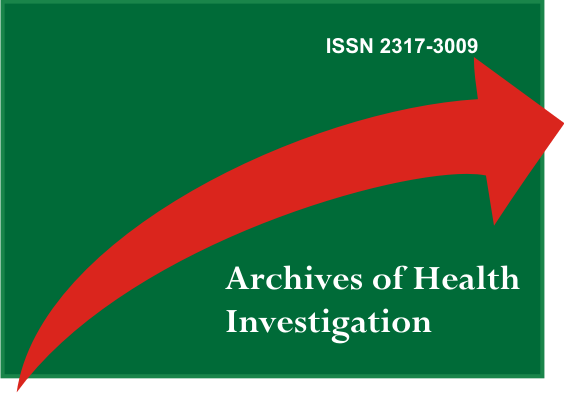Reabilitação De Maxila Atrófica Com Implantes Zigomáticos: Relato De Caso
Resumo
A reabsorção alveolar dos maxilares após a perda dos elementos dentários está relacionada a transtornos funcionais e estéticos, e a dificuldades na reabilitação oral, principalmente quando associado a condições que pioram tal situação, como na síndrome da combinação. Existem várias formas de técnicas e propostas de tratamento para os maxilares atróficos, como enxertos ósseos, uso de materiais aloplásticos e implantes em posições variadas em estruturas anexas, como os implantes zigomáticos. O presente artigo tem o objetivo de relatar um caso de reabilitação de maxila atrófica, em um paciente com sinais da síndrome da combinação, em que foi utilizado implante zigomático bilateralmente, juntamente com 04 implantes na região anterior de maxila sem a utilização de enxerto ósseo.Palavras chave: Atrofia Maxilar, Implantação Dentária, Transplante Ósseo, Síndrome da Combinação.
Downloads
Referências
Aparicio C, Ouazzani W, Aparicio A, Fortes V, Muela R, Pascual A, et al. Extrasinus zygomatic implants: three year experience from a new surgical approach for patients with pronounced buccal concavities in the edentulous maxilla. Clin Imp Den Rel Res. 2010; 12: 55-61.
Stie´Venart M, Malevez C. Rehabilitation of totally atrophied maxilla by means of four zygomatic implants and fixed prosthesis: a 6–40-month follow-up. Int J Oral maxillofac Surg. 2010; 39: 358–63.
Goyatá FR, Tostes VL, Rodrigues CRT, Corga RB, Cunha LG. Sindrome da combinação: relato de caso. Int Dent. 2010; 9:160-4.
Boyne P, Marx RE, Nevins M, Lázaro E, Lilly Le, Aider M, Nummikoski P. A feasibility study evaiuating rhbmp-2/absorbable coiiagen sponge for maxillary sinus fioor augmentation. Int J Period Restor Dent. 1997; 17: 11-25.
Campos AL. Fundamentação dos implantes osseointegrados no tratamento e prevenção da síndrome da combinação. Innov Implant J Biomater Esthet. 2010; 5: 60-4.
Peñarrocha M, Viña JA, Carrilo C, Peñarrocha D.
Rehabilitation of reabsorbed maxillae with implants in buttresses in patients with combination syndrome. J Oral Maxillofac Surg . 2012; 70: 322-30.
Peñarrocha M, García B, Martí E, Boronat A. Rehabilitation of severely atrophic maxillae with fixed implant-supported prostheses using zygomatic implants placed using the sinus slot technique: clinical report on a series of 21 patients. Int J Oral Maxillofac Implants. 2007; 22: 645-50.
Branemark P, Grondahl K, O¨ Hrnell L, Nilsson P, Petruson B, Sensson B, et al. Zygoma fixture in the management of advanced atrophy of the maxilla: technique and long-term results. Scand J Plast Reconstr Surg Hand Surg. 2004; 38: 70–85.
Chrcanovic BR, Pedrosa AR, Custódio ALN. Zygomatic implants: a critical review of the surgical tecniches. Oral Maxillofac Surg. 2013; 17: 1-9.
Balshi TJ, Wolfinger GJ, Shuscavange NJ, Balshi SF. Zygomatic bone-to-implant contact in 77 patients with partially or completely edentulous maxillas. J Oral Maxillofac Surg. 2012; 70: 2065-69.
Reychler H, Olszewski R. Intracerebral penetration of a zygomatic dental. Implant and consequent therapeutic dilemmas: case report. J Oral Maxillofac Implants. 2010; 25:416–8


